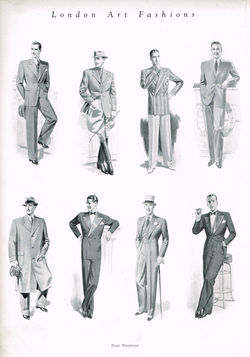
The old fashioned way
A reflection upon times gone by
Eric Musgrave
 These days the term A Cruising Kit might be misinterpreted, but in April 1939 it is obviously aimed at those who enjoyed a summer holiday afloat an ocean liner. There is more stylistic freedom in this evening wear than in the daywear options. Wearers are even encouraged to go for a matching wine-coloured tie and handkerchief if they are far away from England.The model is accessorised with a cigarette, as usual. |  Issue 3777 of The Tailor & Cutter introduces to the delightful language of more than 70 years ago. This sharp three-piece is classed in those better-dressed days as an “informal lounge suit”, or even better “an attractive rig for a day off in the sunshine”. Note the ciggy in our man’s right hand. |  By early April, the T&C editors are suggesting this racy DB number for holiday wear. (I am not quite sure why the words Seaside and Sunshine deserve a capital letter, but there we are). The cloth mills must have loved those wide lapels and wider trousers. “Parti-coloured shoes suggest freedom from care” is a lovely phrase. This fella is a smoker too. |
|---|
The Tailor & Cutter was the magazine for the bespoke trade for more than 100 years. Established in 1866, it survived as a weekly publication until around 1971. In the first of a series of features, menswear authority Eric Musgrave dips into his precious T&C archive to recall what the magazine was promoting in the months just before World War II.
Britain (with France) declared war on Germany on September 3rd 1939 and so a six-year global conflict began. The Second World War was a watershed for British society, so the issues of The Tailor & Cutter from the spring and summer of 1939 reflect a way of life that was soon to disappear.
Each image has its own story written by Eric.
 With all the smoking favoured in 1939, this “reefer outfit” might suggest the wearer enjoys a crafty marijuana joint, but the term reefer describes its DB style. Clutching the world’s slimmest umbrella, this fella is wearing a suit that can be – in modern parlance – dressed up for town or dressed down with “less formal adjuncts” for country use. There’s versatility. |  A couple of outfits that still have a specialist place today in the stylish dresser’s wardrobe. Whether in black with striped trousers or all in silver grey, the morning coat would still see you welcomed at Ascot and smart weddings (although you might look overdressed at any garden party that is not at Buckingham Palace). Note the useful floral tip: “White buttonholes for weddings, coloured carnations at Ascot”. And no tubes of tobacco in sight this time! |  As well as front-page style suggestions, The Tailor & Cutter produced regular seasonal catalogues awash with ideas for its readers to sell to their clients. The T&C empire included a legendary tailoring academy in Gerrard Street, Soho (the building now houses a Chinese supermarket), tailoring correspondence courses that trained craftsmen the world over, and a nice line in selling to tailors the brown-paper patterns for the outfits it promoted. NB: The magazine always stressed that its design ide |  The cover of the May 26 issue is given over to an advertisement for an Irish cloth merchant. This deceptively delicate illustration – truly illustration a nearly lost art form these days – really evokes the texture of flecked Donegal tweed. Those plus-two breeches look very comfortable. Our model, it has to be noted, is somewhat reducing the benefits of a country walk by smoking a cigar. |
|---|---|---|---|
 This illustration from 1939 shows that even 76 years ago the skilful readers of The Tailor & Cutter were being encouraged to make jackets (or coats in bespoke language) without revers or collar. It is a strange look that shows why we all must cry “Long live lapels!” |  After World War II, social changes meant that the number of domestic staff dropped considerably and with it the need for the sort of liveries or what we would now call “corporate uniforms”. Looking at this page, in 1939 the peaked cap business was a good one to be in. |
About the Author:
Eric Musgrave has been writing about fashion and style for 36 years. He is the author of Sharp Suits (Pavilion Books), a pictorial history of men’s tailoring since Victorian times, and has contributed to several other fashion works. As editorial director of Drapers, the UK’s leading fashion industry magazine, he has been twice named business media editor of the year. He is now a freelance writer and fashion industry consultant. See ericmusgrave.co.uk for more details.
